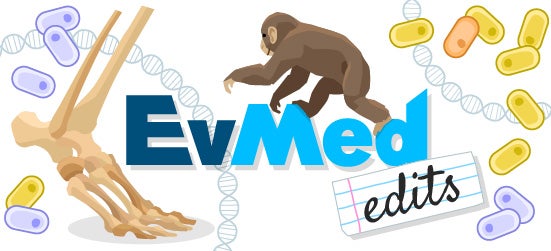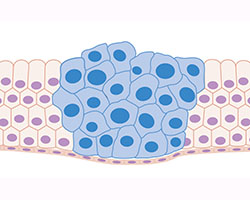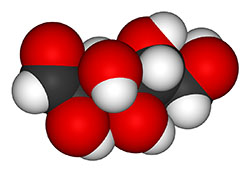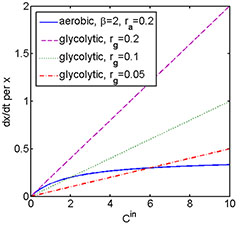
Cooperation in Cancer Cells
What's in the Story?
After a trail of thrilling heists and escaping capture for a month, two suspected diamond thieves were finally captured by police. After a ride to the police station, they were put in separate prison cells for interrogation and were not allowed to talk to each other. Unfortunately, the camera at the jewelry store only shows them in disguise, so the police may not have enough evidence to send both criminals to prison.

To solve this problem, the police try to make each thief a deal. They tell each thief that they could confess, turn in their partner for the crime, and be set free with no prison time; their partner, if they didn’t confess, would serve 3 years in prison. If both thieves turn in their partners, they would each serve 2 years in prison. However, if both thieves remain silent, they each serve only 1 year in prison. In this case, the punishments are smallest if both thieves stay silent, but if one thief wants a better deal, they might be selfish and turn in their partner.
This scenario, called The Prisoner’s Dilemma, may sound like the plot of a TV crime drama, but it is a common way to describe cooperation in human societies and in nature. The prisoners are given the choice to be selfish or to be helpful. Each prisoner has every reason to “cheat”, choosing the selfish option that betrays his or her partner in crime, in order to be set free. Despite this benefit of betrayal for the individual prisoners, remaining silent is the helpful, cooperative choice. Silence is the best choice for both prisoners because they both get less prison time.
Although cancer cells in a tumor do not choose their fate in the same way the prisoners do, there are helpful and selfish strategies available to each cell, just like the prisoners’ two choices. The PLOS ONE article “Prisoner’s Dilemma in Cancer Metabolism” argues that whether or not cancer cells cooperate depends all on the cells’ environment.
Cancer Cells, Betrayal, and Silence

Cancer is a disease in which cells, the smallest unit of life that our bodies are made up of, grow out of control. Instead of working to perform normal bodily functions, they grow past their boundaries, and start working against the body.
Cells, like any living organism, use their energy to survive and reproduce. Cancer cells need to make energy from resources in their environment to survive, grow, and divide. Here is where their Prisoner’s Dilemma comes in: there are two strategies that cancer cells can use to make energy from their “food”, sugar molecules in the tumor environment. One is called aerobic respiration, in which cells use both sugar molecules and oxygen to make energy. The other is called glycolysis, in which cells without access to oxygen (anaerobic) use sugars to make energy--this makes much less energy than is made during aerobic respiration.
Even though glycolysis does not make as much energy as aerobic respiration, cells that use glycolysis release toxic lactic acid. The buildup of this toxin kills nearby healthy cells. This clearing of healthy cells makes more room for cancer cells. Buildup of toxins can only occur if many cells, not just a few, use glycolysis. If enough cells use glycolysis, they make less energy, but cooperate to kill the healthy cells. Cells that use glycolysis help their fellow cancer cells grow and divide. If more cells use aerobic respiration, the selfish strategy, they make more energy for themselves but do not cooperate to kill healthy cells.

Like both prisoners choosing to remain silent, glycolysis is usually the best, most helpful choice for the whole tumor. However, if all of the cancer cells use glycolysis, the amount of lactic acid may become toxic to them, too. When many cells use glycolysis, it helps the cancer cells grow, but too many glycolytic cells can create levels of toxins that are too high, even for the cancer cells. Thus, too many cells using glycolysis can cause “evolutionary suicide”, or the death of all the cancer cells. This makes the dilemma for cancer cells a bit different than the prisoner’s dilemma.
Aerobic respiration is like the prisoner’s betrayal: the selfish choice that helps only individual cells, not the whole group. The use of aerobic respiration does not put all of the cancer cells at risk of evolutionary suicide, but it does not help cancer cells cooperate to kill healthy cells. So we see there are costs and benefits to using glycolysis versus aerobic respiration. Sometimes cells use aerobic respiration and they benefit only themselves, and sometimes they use glycolysis and they benefit the whole population of cancer cells.
Which Cancer Strategy Will Win?
Given that both the helpful and selfish strategies have costs and benefits for cancer cells, how do we know which strategy the cancer cells will use? The researcher hypothesized that glycolysis will be the dominant strategy if the environment lessens the drawbacks of glycolysis. The researcher tests this hypothesis using a mathematical model to determine which strategy will “win” in different environments.

The mathematical model takes into account how much sugar glycolytic and aerobic cells take in and measures the growth of both types of cells. The model can change according to different characteristics of the cells’ environment, like the availability of sugars and oxygen. The model also accounts for death rates of cells and how many cells are using each strategy to begin with.
In the model, cells that use aerobic respiration are limited by oxygen levels and sugar availability. Cells that use glycolysis are only limited by sugar availability. According to the model, each cell will use the strategy that allows them to grow the most under each environmental condition. Modeling cell growth in different environments could not be done in a real tumor in a patient. It would be difficult to change the conditions in a real tumor, and even harder to see what single cells do.
Costs and Benefits Depend on the Environment
This study found that if there are more sugar molecules available in the environment, then the cells in the model that use glycolysis have an advantage. More cells will use glycolysis if a lot of sugar molecules are around. Although the cells make less energy with glycolysis, if more of their food is available they do not have to worry so much about finding sources of energy and can focus on cooperating to kill nearby healthy cells. The same results occur if there is less oxygen available.

On the other hand, if resources like sugar and oxygen are not limited, tumor cells face the Prisoner’s Dilemma. Cancer cells in this model only help each other if enough of them use glycolysis, all producing toxic lactic acid to kill healthy cells and make more room in the environment to grow. However, if too many use glycolysis, the environment becomes so toxic that even the cancer cells die, taking their host with them. The selfish choice of aerobic respiration is more stable over time, but this study demonstrates how the environmental conditions determine whether or not glycolysis is worth it for cells despite the possibility of death from too much lactic acid.
Cancer cells are commonly viewed as cheaters, once-normal cells that have grown past their boundaries and are taking resources away from still-healthy cells. However, in this Prisoner’s Dilemma, cancer cells may use a helpful strategy that allows them to cooperate with other cancer cells or a selfish strategy in which they make extra energy for themselves. Just like the prisoners seeking to keep their sentence as short as possible, cancer cells in this mathematical model may experience the biggest benefits if they use the strategy that benefits all of the cells collectively. This benefit is determined by conditions in the environment. For cancer cells, it's the environment that makes them a deal, not the police.
EvMed Edits are sponsored by ASU's Center for Evolution and Medicine.
Additional images via Wikimedia Commons. Prison bars image by Josh Estey/AusAID.
Read more about: Cooperation in Cancer Cells
Bibliographic details:
- Article: Cooperation in Cancer Cells
- Author(s): Mylan Blomquist
- Publisher: Arizona State University School of Life Sciences Ask A Biologist
- Site name: ASU - Ask A Biologist
- Date published:
- Date accessed:
- Link: https://askabiologist.asu.edu/evmed-edit/cancer-cooperation
APA Style
Mylan Blomquist. (). Cooperation in Cancer Cells. ASU - Ask A Biologist. Retrieved from https://askabiologist.asu.edu/evmed-edit/cancer-cooperation
Chicago Manual of Style
Mylan Blomquist. "Cooperation in Cancer Cells". ASU - Ask A Biologist. . https://askabiologist.asu.edu/evmed-edit/cancer-cooperation
Mylan Blomquist. "Cooperation in Cancer Cells". ASU - Ask A Biologist. . ASU - Ask A Biologist, Web. https://askabiologist.asu.edu/evmed-edit/cancer-cooperation
MLA 2017 Style

Be Part of
Ask A Biologist
By volunteering, or simply sending us feedback on the site. Scientists, teachers, writers, illustrators, and translators are all important to the program. If you are interested in helping with the website we have a Volunteers page to get the process started.

